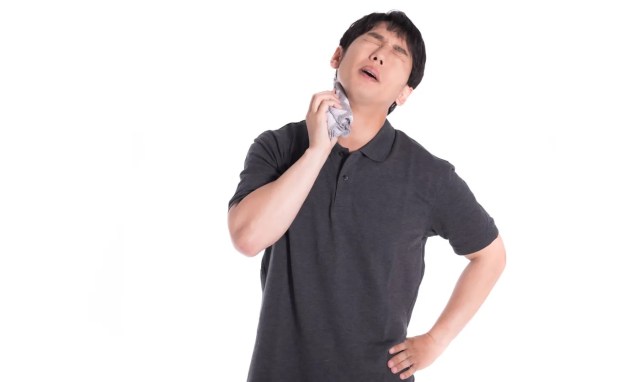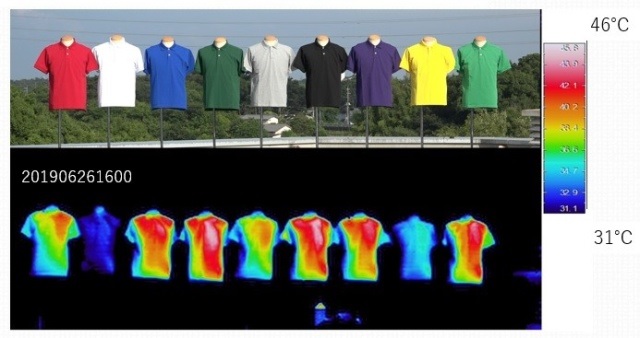
We all know white is cool and black is hot, but what about the colors in between?
Japan is, for the most part, a very safe country. There’s very little violent crime, and few aggressive or poisonous wild animals. There is, however, a potentially serious danger that it’s important to keep in mind at this time of year: heat stroke.
Summer is always hot and humid in Japan, and the last few days have been serious scorchers. Making the situation worse is that for most people living or traveling in Japan, any excursion outside involves plenty of walking, whether you’re making the whole trip to your destination on foot or hoofing it to the station to catch a train which you’ll later get off of before walking again to wherever it is you’re going.
So unless you can just stay inside with the A.C. blasting until mid-autumn, figuring out ways to mitigate the risk of heat exhaustion is critical, and that includes dressing appropriately. Researcher Toshiaki Ichinose, from Japan’s National Institute for Environmental Studies, conducted an experiment to see what color of clothing will keep your body the coolest in the summer sun. Now, it’s pretty common knowledge that white is the coolest and black the hottest, but unless you’re a mime odds are you don’t have an entirely black-and-white wardrobe, so what’s the order of the shades in between?
Before we get to the results, a quick refresher for everyone who’s forgotten junior high science class (or, for you precocious elementary schoolers who read SoraNews24, a sneak peak of what’s to come). We perceive objects as being different colors depending on what wavelengths of light they reflect and absorb. Objects we see as white reflect almost all wavelengths of light, and their heat energy along with them. On the other end of the scale, things we see as black absorb light of just about every wavelength, and its heat too.
For the experiment Ichinose set nine mannequin torsos out in the Japanese summer sun, each clad in a different colored polo shirt, then after five minutes of exposure checked the fabrics’ surface temperatures.
▼ The shirts used in the experiment
As expected, the white shirt was the coolest, with a temperature of approximately 30 degrees Celsius (86 degrees Fahrenheit), more or less the same as the air temperature during the test, followed by yellow. The next coolest shirts, in order, were gray and red, the latter a surprise since red is generally though of as a “hot” color in terms of psychological effect.
Purple ended up right in the middle of the pack, with the next, blue, again being somewhat unexpected, since in visual design it’s considered a “cool” color. Next came green, then dark green, and, finally, black, with the last two both having surface temperatures of over 50 degrees Celsius (122 Fahrenheit), more than 50 percent hotter than the white shirt.
Though the experiment was conducted in June of 2019, the fundamental laws of science still apply, and with late-summer temperatures often hitting daytime highs of 35 degrees or more in Tokyo, it’s even more important to look for any and all ways to stay cool.
Source: Weather News via Yahoo! Japan News, National Institute for Environmental Studies
Top image: Pakutaso
Insert images: National Institute for Environmental Studies
● Want to hear about SoraNews24’s latest articles as soon as they’re published? Follow us on Facebook and Twitter!


 Japan Weather Association creates new words to describe merciless summer heat
Japan Weather Association creates new words to describe merciless summer heat Japanese summer is worse than summer in Death Valley, says our correspondent, a seasoned traveler
Japanese summer is worse than summer in Death Valley, says our correspondent, a seasoned traveler Japanese delivery company tests ideal kotatsu temperature for cats, with live cats
Japanese delivery company tests ideal kotatsu temperature for cats, with live cats It’s so hot in Japan that people are cooking food in/on their cars【Photos】
It’s so hot in Japan that people are cooking food in/on their cars【Photos】 Why is it so hard to find hot sake in convenience stores in Japan?
Why is it so hard to find hot sake in convenience stores in Japan? Foreigner’s request for help in Tokyo makes us sad for the state of society
Foreigner’s request for help in Tokyo makes us sad for the state of society Harajuku Station’s beautiful old wooden building is set to return, with a new complex around it
Harajuku Station’s beautiful old wooden building is set to return, with a new complex around it Japanese city loses residents’ personal data, which was on paper being transported on a windy day
Japanese city loses residents’ personal data, which was on paper being transported on a windy day Heartwarming response to Twitter question confirms that yes, Tikuwa_0913, there is a Santa Claus
Heartwarming response to Twitter question confirms that yes, Tikuwa_0913, there is a Santa Claus Suntory x Super Mario collaboration creates a clever way to transform into Mario【Videos】
Suntory x Super Mario collaboration creates a clever way to transform into Mario【Videos】 Pokémon Sleep camping suite and guestrooms coming to Tokyo Hyatt along with giant Snorlax burgers
Pokémon Sleep camping suite and guestrooms coming to Tokyo Hyatt along with giant Snorlax burgers We try out “Chan Ramen”, an underground type of ramen popular in the ramen community
We try out “Chan Ramen”, an underground type of ramen popular in the ramen community Starbucks Japan adds a Motto Frappuccino to the menu for a limited time
Starbucks Japan adds a Motto Frappuccino to the menu for a limited time Anime girl English teacher Ellen-sensei becomes VTuber/VVTUber and NFT
Anime girl English teacher Ellen-sensei becomes VTuber/VVTUber and NFT Ghibli Park now selling “Grilled Frogs” from food cart in Valley of Witches
Ghibli Park now selling “Grilled Frogs” from food cart in Valley of Witches McDonald’s new Happy Meals offer up cute and practical Sanrio lifestyle goods
McDonald’s new Happy Meals offer up cute and practical Sanrio lifestyle goods Japanese ramen restaurants under pressure from new yen banknotes
Japanese ramen restaurants under pressure from new yen banknotes French Fries Bread in Tokyo’s Shibuya becomes a hit on social media
French Fries Bread in Tokyo’s Shibuya becomes a hit on social media Studio Ghibli releases new action figures featuring Nausicaä of the Valley of the Wind characters
Studio Ghibli releases new action figures featuring Nausicaä of the Valley of the Wind characters New private rooms on Tokaido Shinkansen change the way we travel from Tokyo to Kyoto
New private rooms on Tokaido Shinkansen change the way we travel from Tokyo to Kyoto Red light district sushi restaurant in Tokyo shows us just how wrong we were about it
Red light district sushi restaurant in Tokyo shows us just how wrong we were about it Tokyo Tsukiji fish market site to be redeveloped with 50,000-seat stadium, hotel, shopping center
Tokyo Tsukiji fish market site to be redeveloped with 50,000-seat stadium, hotel, shopping center All-you-can-drink Starbucks and amazing views part of Tokyo’s new 170 meter-high sky lounge
All-you-can-drink Starbucks and amazing views part of Tokyo’s new 170 meter-high sky lounge Beautiful Ghibli sealing wax kits let you create accessories and elegant letter decorations【Pics】
Beautiful Ghibli sealing wax kits let you create accessories and elegant letter decorations【Pics】 Studio Ghibli releases Kiki’s Delivery Service chocolate cake pouches in Japan
Studio Ghibli releases Kiki’s Delivery Service chocolate cake pouches in Japan New definition of “Japanese whiskey” goes into effect to prevent fakes from fooling overseas buyers
New definition of “Japanese whiskey” goes into effect to prevent fakes from fooling overseas buyers Our Japanese reporter visits Costco in the U.S., finds super American and very Japanese things
Our Japanese reporter visits Costco in the U.S., finds super American and very Japanese things Studio Ghibli unveils Mother’s Day gift set that captures the love in My Neighbour Totoro
Studio Ghibli unveils Mother’s Day gift set that captures the love in My Neighbour Totoro More foreign tourists than ever before in history visited Japan last month
More foreign tourists than ever before in history visited Japan last month New Pokémon cakes let you eat your way through Pikachu and all the Eevee evolutions
New Pokémon cakes let you eat your way through Pikachu and all the Eevee evolutions Sales of Japan’s most convenient train ticket/shopping payment cards suspended indefinitely
Sales of Japan’s most convenient train ticket/shopping payment cards suspended indefinitely Sold-out Studio Ghibli desktop humidifiers are back so Totoro can help you through the dry season
Sold-out Studio Ghibli desktop humidifiers are back so Totoro can help you through the dry season Japanese government to make first change to romanization spelling rules since the 1950s
Japanese government to make first change to romanization spelling rules since the 1950s Ghibli founders Toshio Suzuki and Hayao Miyazaki contribute to Japanese whisky Totoro label design
Ghibli founders Toshio Suzuki and Hayao Miyazaki contribute to Japanese whisky Totoro label design Doraemon found buried at sea as scene from 1993 anime becomes real life【Photos】
Doraemon found buried at sea as scene from 1993 anime becomes real life【Photos】 Tokyo’s most famous Starbucks is closed
Tokyo’s most famous Starbucks is closed One Piece characters’ nationalities revealed, but fans have mixed opinions
One Piece characters’ nationalities revealed, but fans have mixed opinions We asked a Uniqlo employee what four things we should buy and their suggestions didn’t disappoint
We asked a Uniqlo employee what four things we should buy and their suggestions didn’t disappoint Princesses, fruits, and blacksmiths: Study reveals the 30 most unusual family names in Japan
Princesses, fruits, and blacksmiths: Study reveals the 30 most unusual family names in Japan We try it out: Does Uniqlo’s HeatTech Ultra Warm work on a motorbike ride in the dead of winter?
We try it out: Does Uniqlo’s HeatTech Ultra Warm work on a motorbike ride in the dead of winter? Japanese media finds out if it’s cold enough to “fry” an egg on the street in Hokkaido
Japanese media finds out if it’s cold enough to “fry” an egg on the street in Hokkaido 10 girls rushed to hospital for heatstroke after Tokyo high school’s non-air-conditioned assembly
10 girls rushed to hospital for heatstroke after Tokyo high school’s non-air-conditioned assembly Bottled hot water selling like bottled hot cakes in Japan
Bottled hot water selling like bottled hot cakes in Japan Japanese company develops personal fryer for easy and delicious meals
Japanese company develops personal fryer for easy and delicious meals No electricity? No problem! Empty plastic bottles are helping to cool homes in impoverished areas
No electricity? No problem! Empty plastic bottles are helping to cool homes in impoverished areas Stray dogs head to convenience stores in Thailand, receive free rabies shots and flea care
Stray dogs head to convenience stores in Thailand, receive free rabies shots and flea care Tokyo too hot for you? It’s already snowing in Hokkaido, Japan’s northern island【Photos】
Tokyo too hot for you? It’s already snowing in Hokkaido, Japan’s northern island【Photos】 Japanese vending machines set to become cooler than ever by selling sub-zero soft drinks
Japanese vending machines set to become cooler than ever by selling sub-zero soft drinks Free literal forest bathing in Hokkaido is a hot spring experience you’ll never forget【Photos】
Free literal forest bathing in Hokkaido is a hot spring experience you’ll never forget【Photos】 700-year-old swordcrafting ceremony lives on in Gifu Prefecture【Video】
700-year-old swordcrafting ceremony lives on in Gifu Prefecture【Video】 Midwinter “cherry blossoms” are making one of Japan’s best castles even more stunning【Photos】
Midwinter “cherry blossoms” are making one of Japan’s best castles even more stunning【Photos】 Japan seems just a little more terrifying with discovery of local leech’s superpower
Japan seems just a little more terrifying with discovery of local leech’s superpower Japan’s 3-D Shiba glasses dress up in kimono for wonderful wafuku tea time【Photos】
Japan’s 3-D Shiba glasses dress up in kimono for wonderful wafuku tea time【Photos】
Leave a Reply